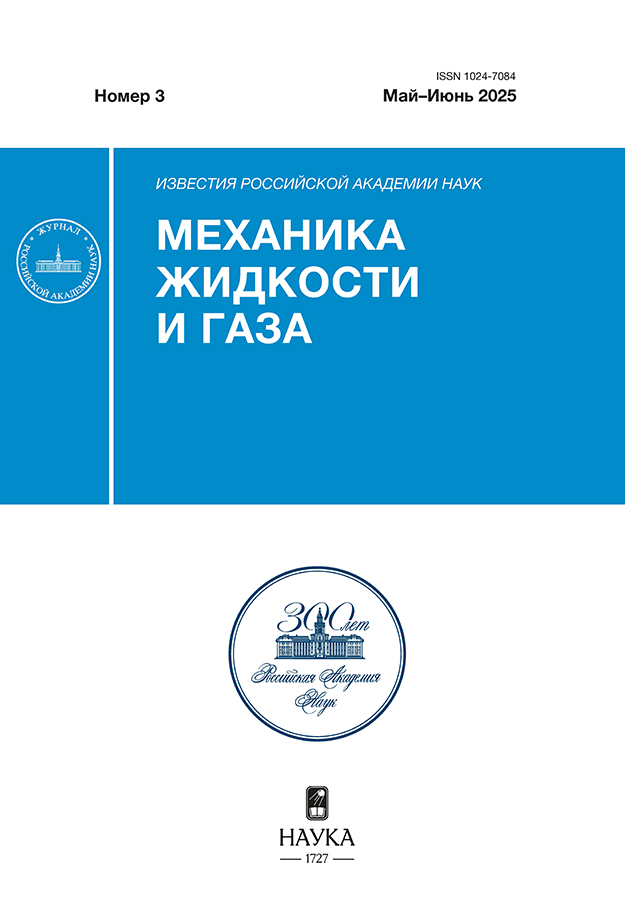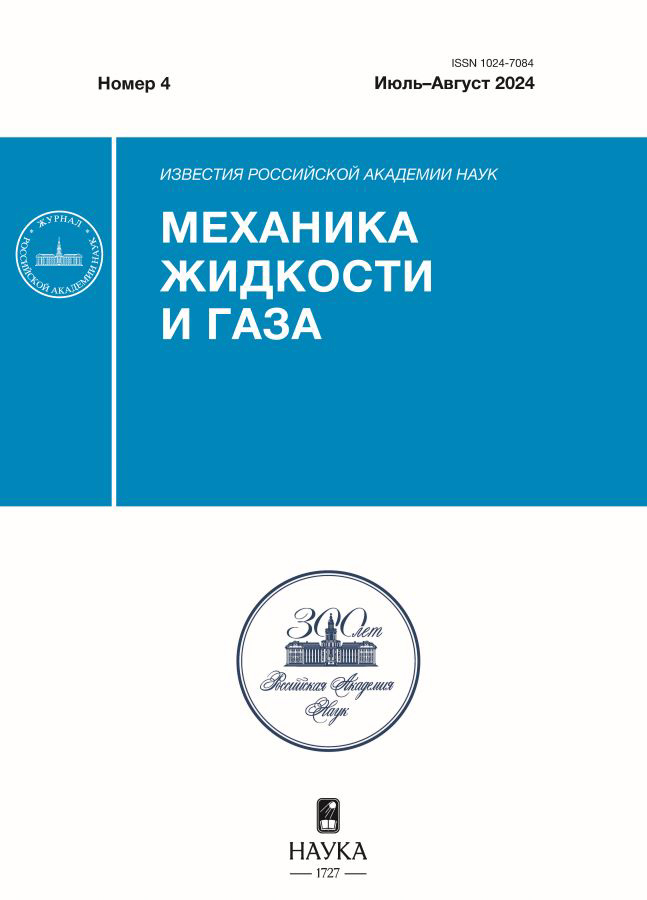Distinctive features of propagation of a turbulent pulsed gas-droplet eddy cloud
- Authors: Pakhomov M.A.1, Terekhov V.P.1
-
Affiliations:
- Kutateladze Institute of Thermophysics, Russian Academy of Sciences, Siberian Branch
- Issue: No 4 (2024)
- Pages: 55-68
- Section: Articles
- URL: https://clinpractice.ru/1024-7084/article/view/682520
- DOI: https://doi.org/10.31857/S1024708424040041
- EDN: https://elibrary.ru/OYQTTI
- ID: 682520
Cite item
Abstract
We present the results of the numerical modeling of the formation and motion of a blown solitary pulsed turbulent gas-droplet jet under the conditions approximately corresponding to human cough. The calculations are performed for the pulse duration t = 0.6 s and the greatest velocity of the gas phase of 20 m/s at the mass content of droplets ML1 = 1%. The drop phase in the exit section is monodisperse, while the initial dimension of particles in the calculations varied in the range D1 = 5‒30 μm. Two zones of elevated vorticity are formed within the cloud in the initial period of motion. They are situated in the mixing layer and in the region of deceleration of two-phase pulsed jet. The greatest levels of the longitudinal velocity and the kinetic energy of turbulence are attained in the interval of pulse blow-off. At the subsequent moments of time the turbulence velocity and level monotonically decrease. The vortex cloud produced by the solitary pulse exists for a fairly long time (t ≈ 4 s) and has a time to penetrate into the surrounding space at a distance greater than 3 m.
Keywords
Full Text
About the authors
M. A. Pakhomov
Kutateladze Institute of Thermophysics, Russian Academy of Sciences, Siberian Branch
Author for correspondence.
Email: pma41976@yandex.ru
Russian Federation, Novosibirsk
V. P. Terekhov
Kutateladze Institute of Thermophysics, Russian Academy of Sciences, Siberian Branch
Email: terekhov@itp.nsc.ru
Russian Federation, Novosibirsk
References
- Ахметов Д.Г. Вихревые кольца. Новосибирск: ГЕО, 2007. 152 с.
- Maxworthy T. Turbulent vortex rings // J. Fluid Mech. 1974. V. 64. № 2. P. 227–239.
- Glezer A., Coles D. An experimental study of a turbulent vortex ring // J. Fluid Mech. 1990. V. 211. P. 243–283.
- Тарасов В.Ф., Якушев В.И. Экспериментальные исследования переноса примеси турбулентным вихревым кольцом // ПМТФ. 1974. № 1. С. 130–136.
- Sangras R., Kwon O.C., Faeth G.M. Self-preserving properties of unsteady round nonbuoyant turbulent starting jets and puffs in still fluids // ASME J. Heat Transfer. 2002. V. 124 (3). P. 460–469.
- Никулин В.В. Массообмен между атмосферой турбулентного вихревого кольца и окружающей средой // Изв. РАН. МЖГ. 2021. № 4. С. 33–40.
- Засимова М.А., Рис В.В., Иванов Н.Г. Численное моделирование формирования и движения турбулентных вихревых облаков // Изв. РАН. МЖГ. 2023. № 5. С. 57–69.
- Gralton J., Tovey E., McLaws M.L., Rawlinson W.D. The role of particle size in aerosolised pathogen transmission: A review // J. Infection. 2011. V. 62(1). P. 1–13.
- Bu Y., Ooka R., Kikumoto H., Oh W. Recent research on expiratory particles in respiratory viral infection and control strategies: A review // Sustainable Cities Soc. 2021. V. 73. P. 1–16.
- Bourouiba L. The fluid dynamics of disease transmission // Ann. Rev. Fluid Mech. 2021. V. 53. P. 473–508.
- Pourfattah F., Wang L.P., Deng W.W., Ma Y.F., Hu L.Q., Yang B. Challenges in simulating and modeling the airborne virus transmission: A state-of-the-art review // Phys. Fluids. 2021. V. 33. Paper 101302.
- Ghaem-Maghami E., Johari H. Velocity field of isolated turbulent puffs // Phys. Fluids. 2010. V. 22. Paper 115105.
- Dbouk T., Drikakis D. On coughing and airborne droplet transmission to humans // Phys. Fluids. 2020. V. 32. Paper 053310.
- Gharib M., Rambod E., Shariff K. A universal time scale for vortex ring formation // J. Fluid Mech. 1998. V. 360. P. 121–140.
- Gupta J.K., Lin C.H., Chen Q. Flow dynamics and characterization of a cough // Indoor Air. 2009. V. 19(6). P. 517–525.
- Dudalski N., Mohamed A., Mubareka S., Bi R., Zhang C., Savory E. Experimental investigation of far-field human cough airflows from healthy and influenza-infected subjects // Indoor Air. 2020. V. 30. P. 966–977.
- Chao C.Y.H., Wan M.P., Morawska L., Johnson G.R., Ristovski Z.D., Hargreaves M., Mengersen K., Corbett S., Li Y., Xie X., Katoshevski D. Characterization of expiration air jets and droplet size distributions immediately at the mouth opening // J. Aerosol Sci. 2009. V. 40. P. 122–133.
- Arumuru V., Pasa J., Samantaray S.S. Experimental visualization of sneezing and efficacy of face masks and shields // Phys. Fluids. 2020. V. 32. Paper 115129.
- Menter F.R. Two-equation eddy-viscosity turbulence models for engineering application // AIAA J. 1994. V. 32. P. 1598–1605.
- Wei J., Li Y. Enhanced spread of expiratory droplets by turbulence in a cough jet // Build. Environ. 2015. V. 93. P. 86–96.
- Gosman A.D., Ioannides E. Aspects of computer simulation of liquid-fuelled combustors // J. Energy. 1983. V.7. P. 482–490.
- Li X.D., Shang Y.D., Yan Y.H., Yang L., Tu J.Y. Modelling of evaporation of cough droplets in inhomogeneous humidity fields using the multi-component Eulerian-Lagrangian approach // Build. Environ. 2018. V. 128. P. 68–76.
- Fabregat A., Gisbert F., Vernet A., Ferre J.A., Mittal K., Dutta S., Pallares J. Direct numerical simulation of turbulent dispersion of evaporative aerosol clouds produced by an intense expiratory event // Phys. Fluids. 2021. V. 33. Paper 033329.
- Papoutsakis A., Danaila I., Luddens F., Gavaises M. Droplet nuclei caustic formations in exhaled vortex rings // Sci. Rep. 2022. V. 12. Paper 3892–3908.
- Calmet H., Inthavong K., Both A., Surapaneni A., Mira D., Egukitza B., Houzeaux G. Large eddy simulation of cough jet dynamics, droplet transport, and inhalability over a ten minute exposure // Phys. Fluids. 2021. V. 33. Paper 125122.
- Shima N. Low-Reynolds-number second-moment closure without wall-refection redistribution terms // Int. J. Heat Fluid Flow 1998.V. 19. P. 549–555.
- Пахомов М.А., Терехов В.И. Численное исследование турбулентной структуры полидисперсной двухфазной струи с испаряющимися каплями // Мат. моделирование. 2016. Т. 28. № 11. С. 64–78.
- Пахомов М.А., Терехов В.И. Структура течения и турбулентный тепломассоперенос в лобовой точке импактной импульсной газокапельной струи // ТВТ. 2014. Т. 52. № 4. С. 588–596.
- Pakhomov M.A., Terekhov V.I. RANS modeling of flow structure and turbulent heat transfer in pulsed gas-droplet mist jet impingement // Int. J. Thermal Sci. 2016. V. 100. P. 284–297.
- Chan C.K., Zhang H.Q., Lau K.S. An improved stochastic separated flow model for turbulent two-phase flow // Comp. Mech. 2000. V. 24. P. 491–502.
- Osiptsov A.N. Lagrangian modeling of dust admixture in gas flows // Astrophys. Space Sci. 2000. V. 274. P. 377–386.
- Osiptsov A.N. Development of the full Lagrangian approach for modeling dilute dispersed media flows (a Review) // Fluid Dynamics. 2024. V. 59, № 1. P. 1–48.
- Лебедева Н.А., Осипцов А.Н. Течения вблизи критических точек при несимметричном столкновении вязких дисперсных потоков // Изв. РАН. МЖГ. 2007. № 5. С. 85–97.
- Rybdylova O., Osiptsov A.N., Sazhin S.S., Begg S., Heikal M. A combined viscous-vortex, thermalblob and Lagrangian method for non-isothermal, two-phase flow modelling // Int. J. Heat Fluid Flow. 2016. V. 58. P. 93–102.
- Годенко Е.А., Измоденов В.В. Сравнение Эйлерова и Лагранжева подходов для нахождения особенностей распределения межзвездной пыли в гелиосфере в рамках модели холодного газа // Изв. РАН. МЖГ. 2023. № 2. С. 138–150.
- Деревич И.В., Зайчик Л.И. Осаждение частиц из турбулентного потока // Изв. АН СССР. МЖГ. 1988. № 5. С. 96–104.
- Beishuizen N.A., Naud B., Roekaerts D. Evaluation of a modified Reynolds stress model for turbulent dispersed two-phase flows including two-way coupling // Flow, Turbulence, Combust. 2007. V. 79. P. 321–341.
- Zaichik L.I. A statistical model of particle transport and heat transfer in turbulent shear flows // Phys. Fluids. 1999. V. 11. P. 1521–1534.
- Derevich I.V. Statistical modelling of mass transfer in turbulent two-phase dispersed flows. 1. Model development // Int. J. Heat Mass Transfer. 2000. V. 43. P. 3709–3723.
- Abramzon B., Sirignano W.A. Droplet vaporization model for spray combustion calculations // Int. J. Heat Mass Transfer. 1989.V. 32(9). P. 1605–1618.
- Moukalled F., Darwish M. Pressure based algorithms for multi-fluid flow at all speeds-part I: Mass conservation formulation // Numerical Heat Transfer, B. 2004. V. 45. P. 495–522.
- Крашенинников С.Ю. К расчету осесимметричных закрученных и незакрученных турбулентных струй // Изв. СССР. МЖГ. 1972. № 3. С. 71–80.
- Zhang Z., Jiang P.-X., Hu Y.-T., Li J. Experimental investigation of continual and intermittent-spray cooling // Exp. Heat Transfer. 2013. V. 26. P. 453–469.
- Назаров А.Д., Серов А.Ф., Терехов В.И. Влияние спутного газового потока в импульсном аэрозоле на процесс испарительного охлаждения // ТВТ. 2014. Т. 52. № 4. С. 605–608.
- Picano F., Sardina G., Gualtieri P., Casciola C.M. Anomalous memory effects on transport of inertial particles in turbulent jets // Phys. Fluids. 2010. V. 22. Paper 051705.
- Mazzino A., Rosti M.E. Unraveling the secrets of turbulence in a fluid puff // Phys. Rev. Lett. 2021. V. 127. № 9. P. 1–6.
- Wang X.K., Su B.Y., Li Y.L., Wang C. Vortex formation and evolution process in an impulsively starting jet from long pipe // Ocean Eng. 2019. V. 176. P. 134–143.
- Ferrand V., Bazile R., Boree J. Measurements of concentration per size class in a dense polydispersed jet using planar laser induced fluorescence and phase Doppler techniques // Exp. Fluids. 2001. V. 31. № 6. P. 597–607.
- Chen Y.-C., Starner S.H., Masri A.R. A detailed experimental investigation of well-defined, turbulent evaporating spray jets of acetone // Int. J. Multiphase Flow. 2006. V. 32. № 4. P. 389–412.
Supplementary files

















